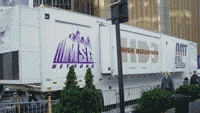HD remote broadcasting

Initially, HD trucks were hybrid units, with most cameras and VTRs producing HD, but with other sources, namely graphics devices, outputting SD that was upconverted to HD. At the output of the truck, an HD-to-SD conversion was required for the main backhaul to the network or station. Another early drag on HD production was that most early HD-SDI equipment worked in only one HD format — 1080i, which meant that networks not using that format had to make an additional conversion.
National Mobile Television’s (NMT) HD3 high-definition, double expando unit (pictured) is equipped with an HDVS-7000 switcher, HDC-700 studio cameras, HDW-500 HDCAM digital VTRs and a HDME-7000 dual-channel DVE, all from Sony; 65x1 Canon lenses; and a Chyron HD iNFiNiT! It delivers audio via Solid State Logic’s Aysis Air Plus digital console.
To limit the amount of upconversion, early HD trucks used a dual-path approach. This used to consist of two trucks parked next to one another, with one truck producing the SD program and the other the HD counterpart. This was the case three years ago when Panasonic provided the HD version of “Monday Night Football,” and ABC provided the SD version with what is now NMT's DX-10 unit. Separate sources and crews produced two separate and independent shows.
The next step in the evolution was to share sources. Most HD cameras produce HD and SD outputs, so the HD outputs fed the HD infrastructure while the SD outputs were sent to the SD truck. Graphics were generally SD, so they were sent from the SD truck to upconverters in the HD truck. That way, no downconversion had to be done at the output of the HD truck.
From there, dual-path production moved to a single audio infrastructure between the two trucks, with a single technical director (TD) controlling HD and SD switchers for both trucks from a single control panel (see Figure 1). Until a few years ago, a switcher's control panel was tightly married to its processing frame, and it took some heroics to get one panel to control multiple frames. Today many high-end switcher control panels control their corresponding processors via LAN connections, and a single TD can switch the HD and SD programs from a single control panel in one of the trucks. Inversely, multiple control panels can control a single switching frame. As switching matrices continue to get larger and more powerful, a single acquisition and distribution infrastructure might allow a central processing truck to handle the production capabilities of multiple productions at a single. In the future, a central infrastructure truck with only the switching matrix could be under the command of a number of other trucks that only have switcher control panels networked to the central truck.
Figure 1. Today’s switchers use LAN connections, making it possible not only for one control panel to control two processors, but also for multiple control panels to control the same processor. Image courtesy Thomson Grass Valley.
In early switchers, effects buses cascaded from one bank to the next. By contrast, effects banks in today's switchers are in parallel and able to work independently of or in concert with other banks. The switcher serves as a bank of resources that can be commandeered by a single user, or allocated to multiple users.
The professional video industry's #1 source for news, trends and product and tech information. Sign up below.
Early adopters such as NMT built trucks that had HD infrastructures at their core with complete, separate SD infrastructures. In the HD show, SD sources were upconverted as necessary.
Core Digital Technologies/SWTV introduced another dual-path approach, with separate switcher processors for HD and SD in the same truck under control of a single TD. SD sources are upconverted for the HD switcher processor, and HD sources undergo downconversion for the SD side.
Another important development by equipment vendors that might make HD production ubiquitous is the ability of new equipment to produce multiple HD formats. Devices like routers can work in either 720p/60 or 1080i/30, and now sources and processing devices such as cameras and switchers are available that can be switched between the two formats. Because Disney/ABC/ESPN are entrenched in the 720p camp, and CBS and NBC in the 1080i camp, devices that work in both have made investing in an HD truck a bit more palatable.
An HD camera with a Digi87 lens from Fujinon capturing action at the Army/Navy football game. Photo courtesy Core Digital Technologies/SWTV.
Many new HD trucks will hit the road, and some will use the Thomson LDK-6000 camera, which provides 720p and 1080i native formats through many sensors in its CCD array. The camera's CCD array has 9.2 million cells arrayed 1920 H by 4320 V. With massive oversampling, this allows for two sets of subsampling outputs to derive the desired HD format. The cells are grouped together to create pixels of the size needed for the chosen format. For instance, in the case of 1080i operation, four cells are grouped together vertically (4320/4) to create 1080 individual vertical lines. These elastic horizontal/vertical pixels provide the proper horizontal resolution in either mode. This approach also allows for the same lenses to be used in all operating modes.
The CG is another device that will one day facilitate a single-truck solution with multiple deliverable streams. Besides resolution, the obvious difference between HD and most SD is the aspect ratio. Graphics used in 16:9 vs. 4:3 usually have different composition and layout requirements. Typically, graphics are created for the SD show and then upconverted to HD, which usually means graphics are fattened up to fill the increased width of the 16:9 aspect ratio. Some CGs will output a core graphic specifically for each format. Most composite graphics today consist of individual objects that are put together only when the graphic is needed. This allows the elements of a graphic to be placed on the horizontal plane based on how wide the final picture will be.
The rear-screen projection wall in Core Digital Technologies/SWTV’s HD601 remote unit.
A stopgap method of dealing with differing aspect ratios is a process called Dual-Layer by NEP. Thomson Grass Valley will implement this in the Kalypso production switcher by having M/E effects banks that operate in parallel with the exception of the key signal. In HD/SD production, the native source (HD or SD) could go through a DVE to position the graphics display for the non-native path. The Thomson HD 35 switcher has this capability also.
HD production is more complex both in live environments and in the post environment. Often a live cut of the show is recorded along with iso camera shots. Traditionally iso and the show cut recorded versions were synchronized via time code. With HD and all the accompanying processing that can occur, the propagation paths from source to various recording devices can vary. When this happens, the time code stamps for iso and main recordings are offset by the difference in paths.
At the Super Bowl last year, FOX unveiled what will likely also become the near-term solution for the 4:3/16:9 issue. They operate character generation and graphics systems in the 16:9 mode, but frame the text for the 4:3 picture area, allowing them to provide graphic content that spans the 16:9 frame but leaves critical content in the 4:3 frame. This avoids the anamorphic distortion in the conversion from 4:3 to 16:9 or vice versa. It is highly likely that this is the approach that ESPN and ABC will adopt until technology catches up with production requirements.
The economics of HD
The multiformat capability of new equipment helps the economics of the HD truck business, but it's still not a business for the financially faint of heart. SD trucks can easily cost four million dollars, and HD trucks can range from 50 percent to 100 percent more than an SD truck of similar capability. Multiple-format HD equipment can put the cost of the HD truck closer to the high end of this range. HD trucks, even ones that do not go the dual-path route, still need SD layers — to make monitoring as economical as possible if nothing else. Design, construction and implementation of an HD vehicle are tougher, and thus more expensive, than an SD project.
Early HD trucks had other requirements over SD trucks. They consumed much more power — typically 50 percent to 100 percent more. Video bit rates for HD are more than five times higher than SD rates. Logic circuits therefore spend more time in transition states with HD bitstreams than with SD streams, increasing the amount of power required. Some early HD trucks drew upwards of 150kW. This higher power consumption meant more heat to cope with and necessitated much larger HVAC packages. However, newer HD equipment requires incrementally less power.
Weigh in
The engineering considerations of remote trucks are many. Full-service SD production trucks can easily push the 80,000 pounds bridge weight in this country, and HD trucks are heavier. Gear on an HD truck, especially a dual-path one, can top the scales at more than 15,000 pounds. The weight of cable is often close to the truck's equipment weight. To minimize this, mini coax is used wherever possible. This requires an engineering balancing act, as the mini coax limits path runs for HD signals between reclocking devices to a couple hundred feet. But the increased weight on an HD truck also requires that equipment be dispersed throughout the trailer so the weight doesn't end up over one axle. To help slim down the base weight of the HD trailer, which historically has been about half the overall unit weight, composite materials for flooring and walls, along with aluminum and even titanium ribbing, are often used for trailer construction.
Moving from SD production to HD requires a steep learning curve, even for seasoned veterans. The return on investment to be in the HD production business may still be in doubt. But the industry leaders understand that their clients have made a commitment to deliver DTV's full potential — including high-definition video and multichannel audio — and are stepping up to deliver the tools and expertise required.
Jim Boston is a West Coast consultant and the co-author of a book with George Hoover entitled Television on Wheels: The story of Remote Television Production, due for release in February. To find out more about the book visit www.remotetruckbook.com .
The author would like to thank Jerry Gepner and Mark Brooks of NMT and George Hoover of NEP for their help with this article.
